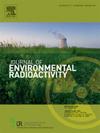2016-2020年,日本福岛东部几条河流中核事故衍生的129I。
IF 2.1
3区 环境科学与生态学
Q3 ENVIRONMENTAL SCIENCES
引用次数: 0
摘要
包括129I在内的放射性核素是由福岛核电站事故释放到大气中的。2016 - 2020年对福岛东部11条河流的溶解性129I浓度进行了测定,以明确基流条件下河流水中的129I浓度水平。研究期间,2016年Ukedo河水体中129I浓度最大值为1.6 × 10-6 Bq -1, 2017年乌达河水体中129I浓度最小值为1.2 × 10-7 Bq -1,两者差异超过一个数量级。福岛东部的Ukedo, Niida-U和Nagadoro河的水样受到福岛事故的强烈影响。此外,我们发现河水中129I浓度与集水区平均129I污染密度之间存在显著的相关性。2016 - 2020年河流水体中129I的时间序列变化较小,无逐年下降趋势。在观测期内,各河流129I浓度与137Cs衰减校正浓度相比几乎没有下降,预计在较长一段时间内会有一定浓度的溶解129I持续流出。本文章由计算机程序翻译,如有差异,请以英文原文为准。

Nuclear accident-derived 129I in several river water, eastern Fukushima, Japan, 2016–2020
Radionuclides, including 129I, were released into the atmosphere by the Fukushima nuclear power plant accident. We measured the dissolved 129I concentration in 11 rivers in eastern Fukushima from 2016 to 2020 to clarify the 129I concentration level in river water under base-flow conditions. During the study period, the maximum 129I concentration in the river water was 1.6 × 10−6 Bq L−1 in the Ukedo River in 2016, and the minimum was 1.2 × 10−7 Bq L−1 in the Uda River in 2017, with a difference of over an order of magnitude between the two. Water samples from the Ukedo, Niida-U, and Nagadoro Rivers in eastern Fukushima were strongly affected 129I from the Fukushima accident. In addition, we found a significant correlation between concentration of 129I in river water and mean 129I contamination density in the catchment. The time-series variation of 129I in river water from 2016 to 2020 was small and showed no year-to-year decrease. The 129I concentration in each river hardly decreased compared to the 137Cs decay-corrected concentration during the observation period, and it was expected that a certain concentration of dissolved 129I would continue to flow out over a long period of time.
求助全文
通过发布文献求助,成功后即可免费获取论文全文。
去求助
来源期刊

Journal of environmental radioactivity
环境科学-环境科学
CiteScore
4.70
自引率
13.00%
发文量
209
审稿时长
73 days
期刊介绍:
The Journal of Environmental Radioactivity provides a coherent international forum for publication of original research or review papers on any aspect of the occurrence of radioactivity in natural systems.
Relevant subject areas range from applications of environmental radionuclides as mechanistic or timescale tracers of natural processes to assessments of the radioecological or radiological effects of ambient radioactivity. Papers deal with naturally occurring nuclides or with those created and released by man through nuclear weapons manufacture and testing, energy production, fuel-cycle technology, etc. Reports on radioactivity in the oceans, sediments, rivers, lakes, groundwaters, soils, atmosphere and all divisions of the biosphere are welcomed, but these should not simply be of a monitoring nature unless the data are particularly innovative.
 求助内容:
求助内容: 应助结果提醒方式:
应助结果提醒方式:


